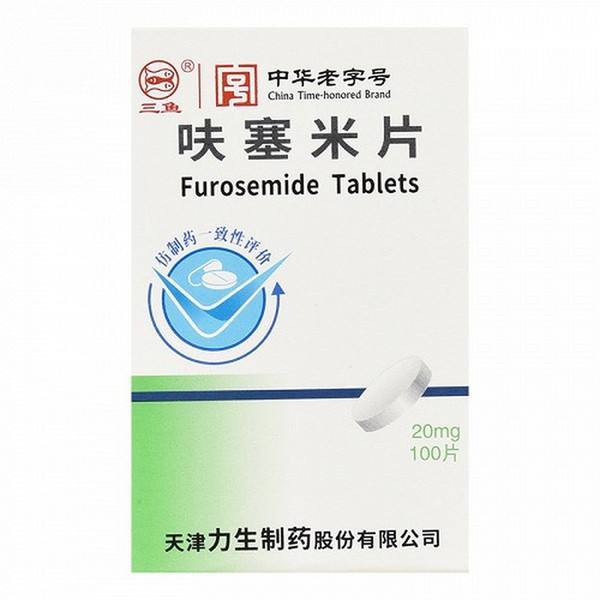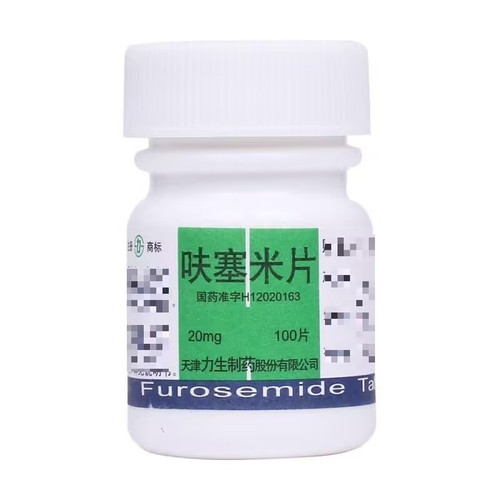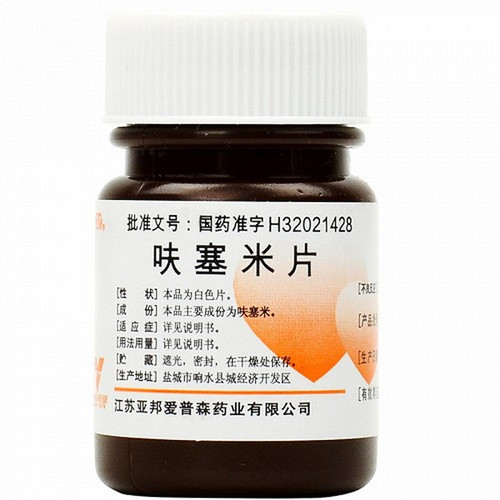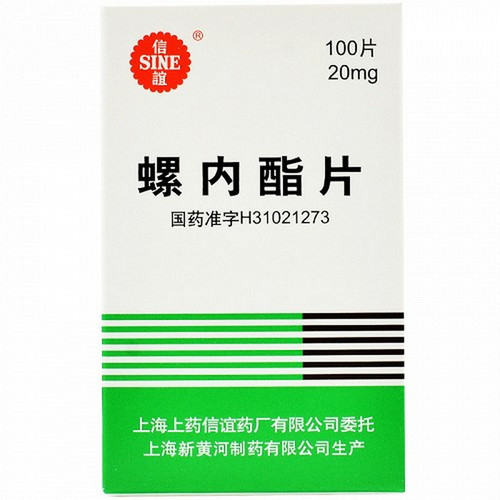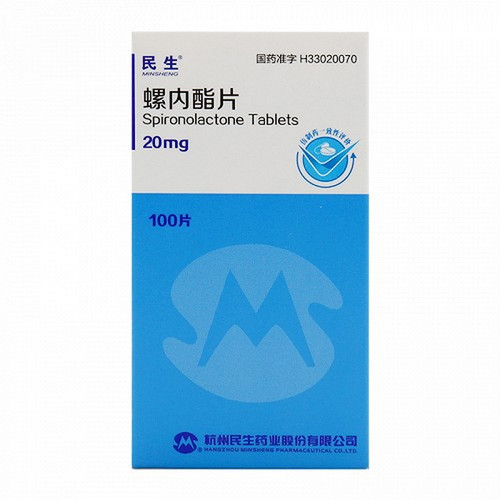Product Overview
[Drug Name]
Generic Name: Furosemide Tablets
Trade Name: Sanyu
English Name: Furosemide
Chinese Pinyin: Fusaimi Pian
[Ingredients]
The main ingredient is furosemide, whose chemical name is 2-[(2-furylmethyl)amino]-5-(sulfamoyl)-4-chlorobenzoic acid. Its structural formula is: Molecular formula: C₁₂H₁₁₁Cl₂N₂O₅S Molecular weight: 330.75
[Properties]
This product is a white tablet.
[Indications]
1. Edema diseases including congestive heart failure, cirrhosis, and renal disease (nephritis, nephropathy, and acute and chronic renal failure due to various causes). This drug may still be effective when other diuretics are ineffective. It can also be used in combination with other drugs to treat acute pulmonary edema and acute cerebral edema. 2. Hypertension is generally not the first choice drug for the treatment of primary hypertension, but when thiazide drugs are ineffective, especially when accompanied by renal insufficiency or hypertensive crisis, this type of drug is particularly suitable. 3. Prevention of acute renal failure. It is used for various reasons leading to insufficient renal blood perfusion, such as dehydration, shock, poisoning, anesthesia accidents and circulatory insufficiency. Timely application while correcting insufficient blood volume can reduce the chance of acute tubular necrosis. 4. Hyperkalemia and hypercalcemia. 5. Dilutional hyponatremia, especially when the blood sodium concentration is lower than 120mmol/L. 6. Syndrome of excessive antidiuretic hormone secretion (SIADH). 7. Acute drug poisoning such as barbiturate poisoning.
[Usage and Dosage]
1. Adults (1) Treatment of edematous diseases. The initial dose is 20-40mg (1-2 tablets) orally once a day. If necessary, add 20-40mg (1-2 tablets) after 6-8 hours until a satisfactory diuretic effect is achieved. Although the maximum dose can reach 600 mg (30 tablets) per day, it should generally be controlled within 100 mg (5 tablets) and taken in 2 to 3 divided doses to prevent excessive diuresis and adverse reactions. For some patients, the dose can be reduced to 20 to 40 mg (1 to 2 tablets) every other day, or taken continuously for 2 to 4 days per week, 20 to 40 mg (1 to 2 tablets) per day. (2) Treatment of hypertension. Start with 40 to 80 mg (2 to 4 tablets) per day, taken in 2 divided doses, and adjust the dose as appropriate. (3) Treatment of hypercalcemia. Take 80 to 120 mg (4 to 6 tablets) orally daily, taken in 1 to 3 divided doses.
2. Children: For the treatment of edematous diseases, start with 2 mg/kg of body weight, orally, and add 1 to 2 mg/kg every 4 to 6 hours if necessary. The dosing interval should be extended for newborns.
[Adverse Reactions]
Common adverse reactions are related to fluid and electrolyte imbalances, especially with high doses or prolonged use. These include orthostatic hypotension, shock, hypokalemia, hypochloremia, hypochloremic alkalosis, hyponatremia, hypocalcemia, and associated thirst, fatigue, muscle aches, and arrhythmias. Less common adverse reactions include allergic reactions (including rash, interstitial nephritis, and even cardiac arrest), blurred vision, xanthoopia, photosensitivity, dizziness, headache, anorexia, nausea, vomiting, abdominal pain, diarrhea, pancreatitis, muscle rigidity, bone marrow suppression leading to granulocytopenia, thrombocytopenic purpura, and aplastic anemia, liver damage, paresthesias of the digits, hyperglycemia, positive urine glucose, exacerbation of pre-existing diabetes, and hyperuricemia. Tinnitus and hearing impairment are more common with high-dose rapid intravenous injection (greater than 4-15 mg per minute). They are usually transient, but a few are irreversible, especially when used concurrently with other ototoxic drugs. In cases of hypercalcemia, this drug may cause kidney stones. There are also reports that this drug may aggravate idiopathic edema.
[Contraindications]
This drug is contraindicated in patients who are allergic to sulfonamides. It is contraindicated in newborns and infants under two months old. It is contraindicated in patients with impaired liver and kidney function.
[Precautions]
(1) Cross-allergy. Patients who are allergic to sulfonamides and thiazide diuretics may also be allergic to this drug. (2) Interference with diagnosis: It may cause increased blood sugar and positive urine sugar, especially in patients with diabetes or prediabetes. Excessive dehydration may temporarily increase blood uric acid and urea nitrogen levels. Blood Na+, Cl-, K+, Ca2+ and Mg2+ concentrations may decrease. (3) Use with caution in the following situations: ① Patients with anuria or severe renal impairment, the latter of which requires a higher dose, so the interval between medications should be extended to avoid side effects such as ototoxicity; ② Diabetes; ③ Hyperuricemia or a history of gout; ④ Severe liver impairment, as water and electrolyte imbalance may induce hepatic coma; ⑤ Acute myocardial infarction, excessive diuresis may precipitate shock; ⑥ Pancreatitis or a history of this condition; ⑦ Patients with a tendency to hypokalemia, especially those taking digitalis or ventricular arrhythmias; ⑧ Lupus erythematosus, as this drug may aggravate the condition or induce activity; ⑨ Prostatic hypertrophy. (4) Follow-up examinations: ① Blood electrolytes, especially those taking digitalis or corticosteroids, or those with liver and kidney impairment; ② Blood pressure, especially for antihypertensive use, high-dose use, or in the elderly; ③ Renal function; ④ Liver function; ⑤ Blood sugar; ⑥ Blood uric acid; ⑦ Acid-base balance; ⑧ Hearing. (5) The drug dosage should start from the minimum effective dose, and then adjust the dose according to the diuretic response to reduce the occurrence of side effects such as water and electrolyte imbalance. (6) When hypokalemia or hypokalemia tendency exists, potassium salt supplementation should be noted. (7) When used in combination with antihypertensive drugs, the latter dose should be adjusted as appropriate. (8) Patients with oliguria or anuria should stop taking the drug if it is still ineffective after 24 hours after taking the maximum dose. (9) Use in pregnant and lactating women: 1. This drug can pass through the placental barrier, and pregnant women, especially those in the first 3 months of pregnancy, should try to avoid using it. It has no preventive effect on pregnancy-induced hypertension syndrome. Animal experiments have shown that this product can cause fetal hydronephrosis, miscarriage and increased fetal mortality. 2. This drug can be secreted through breast milk, and lactating women should use it with caution. (10) Use in children: The half-life of this drug in newborns is significantly prolonged, so the interval between doses for newborns should be extended. (11) Use in elderly patients: The elderly are more likely to experience hypotension, electrolyte imbalance, thrombosis and renal damage when using this drug.
[Use in Special Populations]
Precautions for Children:
This drug has a significantly prolonged half-life in neonates, so the dosing interval should be extended.
Precautions for Pregnancy and Lactation:
1. This drug can cross the placenta; therefore, its use should be avoided during pregnancy, especially during the first three months of pregnancy. It has no preventive effect on pregnancy-induced hypertension. Animal studies have shown that this drug can cause hydronephrosis in the fetus, increasing miscarriage and fetal mortality. 2. This drug is secreted into breast milk; therefore, it should be used with caution in lactating women.
Precautions for Elderly:
The elderly are at increased risk of hypotension, electrolyte imbalances, thrombosis, and renal impairment when using this drug.
[Drug Interactions]
1. Glucose, mineralocorticoids, adrenocorticotropic hormone, and estrogen can reduce the diuretic effect of this drug and increase the risk of electrolyte imbalances, especially hypokalemia. 2. Nonsteroidal anti-inflammatory analgesics can reduce the diuretic effect of this drug and increase the risk of renal damage. This is related to their inhibition of prostaglandin synthesis and reduced renal blood flow. 3. When used in combination with sympathomimetics and anticonvulsants, the diuretic effect is weakened. 4. When used in combination with clofibrate (clofibrate), the effects of both drugs are enhanced, and muscle soreness and stiffness may occur. 5. When used in combination with dopamine, the diuretic effect is enhanced. 6. Alcohol, alcohol-containing preparations, and drugs that can cause a decrease in blood pressure can enhance the diuretic and antihypertensive effects of this drug; when used in combination with barbiturates and anesthetics, it can easily cause orthostatic hypotension. 7. This drug can reduce uric acid excretion and increase blood uric acid levels. Therefore, when used in combination with drugs for the treatment of gout, the dosage of the latter should be appropriately adjusted. 8. It reduces the efficacy of hypoglycemic drugs. 9. It reduces the effects of anticoagulants and antifibrinolytic drugs, mainly due to the decrease in blood volume after diuresis, which leads to an increase in the concentration of coagulation factors in the blood, and the improvement of liver blood supply and increased synthesis of coagulation factors by diuresis. 10. This drug enhances the effects of non-depolarizing muscle relaxants and is related to a decrease in blood potassium. 11 When used in combination with antibiotics such as amphotericin, cephalosporins, and aminoglycosides, nephrotoxicity and ototoxicity increase, especially when there is existing renal damage. 12 When used in combination with antihistamines, ototoxicity increases, and tinnitus, dizziness, and vertigo are likely to occur. 13 When used in combination with lithium, nephrotoxicity increases significantly and should be avoided as much as possible. 14 After taking chloral hydrate, intravenous injection of this drug can cause sweating, facial flushing, and increased blood pressure. This is related to the increase in thyroid hormone from bound to free state, leading to enhanced decomposition. 15 When used in combination with sodium bicarbonate, the chance of hypochloremic alkalosis increases.
[Pharmacological action]
This product is a potent diuretic, and its mechanism of action is as follows. (1) Effect on water and electrolyte excretion. It can increase the excretion of water, sodium, chloride, potassium, calcium, magnesium, phosphorus, etc. Unlike thiazide diuretics, loop diuretics such as furosemide have a clear dose-effect relationship. As the dose increases, the diuretic effect is significantly enhanced, and the drug dosage range is large. This class of drugs primarily inhibits active reabsorption of NaCl in the thick-walled segment of the loop of Henle. This results in increased Na+ and Cl- concentrations in the tubular fluid and decreased Na+ and Cl- concentrations in the medullary interstitial fluid, reducing the osmotic gradient and impairing the tubular concentrating function, leading to increased excretion of water, Na+, and Cl-. Reduced Na+ reabsorption increases Na+ concentration in the distal tubule, promoting increased Na+-K+ and Na+-H+ exchange, and increasing K+ and H+ excretion. The mechanism by which furosemide inhibits Cl- reabsorption in the thick-walled segment of the ascending limb of the loop of Henle was previously believed to involve a chloride pump. Current research suggests that a paired Na+ and Cl- transport system associated with the Na+-K+ ATPase exists on the lateral side of the basement membrane. Furosemide reduces Na+ and Cl- reabsorption by inhibiting this system. Furthermore, furosemide may also inhibit Na+ and Cl- reabsorption in both the proximal and distal tubules, promoting K+ secretion in the distal tubule. Furosemide increases the excretion of Ca2+ and Mg2+ by inhibiting the reabsorption of Ca2+ and Mg2+ by the loop of Henle. Short-term use can increase uric acid excretion, while long-term use can cause hyperuricemia. (2) Effects on hemodynamics. Furosemide can inhibit the activity of prostaglandin degrading enzymes, increase the content of prostaglandin E2, and thus have a vasodilatory effect. Dilation of renal blood vessels, reduction of renal vascular resistance, and increase of renal blood flow, especially blood flow in the deep renal cortex, are of great significance in the diuretic effect of furosemide and are also the theoretical basis for its use in preventing acute renal failure. In addition, unlike other diuretics, loop diuretics increase renal tubular fluid flow while the glomerular filtration rate does not decrease, which may be related to the reduction of chloride flowing through the macula densa, thereby weakening or blocking the glomerular-tubular balance. Furosemide can dilate the pulmonary capacitance veins and reduce the permeability of pulmonary capillaries. In addition, its diuretic effect reduces the amount of blood returning to the heart and reduces the left ventricular end-diastolic pressure, which is helpful for the treatment of acute left heart failure. Furosemide can reduce pulmonary capillary permeability, providing a theoretical basis for its use in the treatment of adult respiratory distress syndrome.
Storage: Store in a dry, light-proof, sealed container.
Specifications: 20mg x 100 tablets
Packaging: Bottle/box
Expiration Date: 24 months
Approval Number: National Medicine Standard H12020163
Manufacturer: Tianjin Lisheng Pharmaceutical Co., Ltd.
